| Author |
Message |
|
Scott Arnold
Location: Philadelphia, Pa. Joined: 16 Dec 2013
Posts: 10
|
 Posted: Thu 19 Dec, 2013 8:05 am Post subject: Scottish Dirk marked R. G. Lawrie Posted: Thu 19 Dec, 2013 8:05 am Post subject: Scottish Dirk marked R. G. Lawrie |
 |
|
I don't know why in the world I told my Father that I would help him find the Who, What and, When his Scottish Dirk was made. But I said itís easy to find these things with my computer (I will never say that again) I have been searching for months trying (Without success) when his dirk made by Lawrie of Scotland Its not silver so I can find out by the hall marks. It looks like it is made of very ornate white metal mounts. Please if anyone knows the answers of when it was made and did Lawrie make it or did they have another smith make it? Any help would put me in your debt. Scott W. Arnold
 Attachment: 34.61 KB Attachment: 34.61 KB
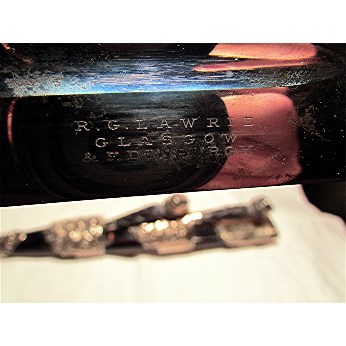
 Attachment: 58.03 KB Attachment: 58.03 KB
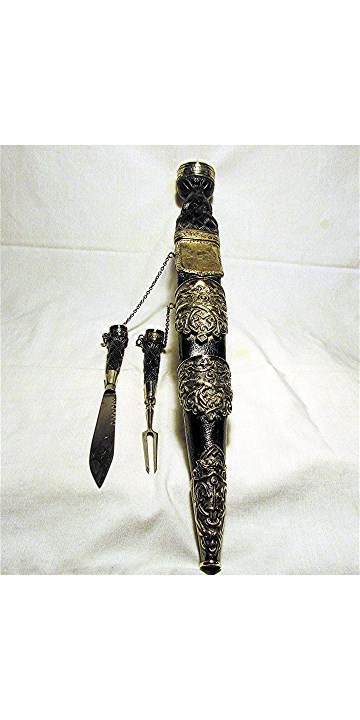
 Attachment: 14.25 KB Attachment: 14.25 KB
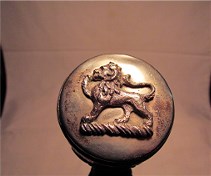
|
|
   |
 |
|
Peter Messent
|
 Posted: Thu 19 Dec, 2013 10:48 am Post subject: Posted: Thu 19 Dec, 2013 10:48 am Post subject: |
 |
|
I turned up this auction for an RG Lawrie sgian dubh: http://www.bonhams.com/auctions/18906/lot/526/
I'm aware of RG Lawrie bagpipes, one in the same I presume? He perhaps made, or at least contracted branded items, other pipe-band items. Another example here:
http://www.carters.com.au/index.cfm/item/1824...gh-dirk-m/
My search also suggests that he was known for bowls (as in lawn-bowls).
As far as I know, he was working in the late 19th century. There is a current shop, Hector Russel-RG Lawrie in Glasgow - I don't know the details of that though, perhaps the business was bought or merged with another?
A beautiful piece!
|
|
  |
 |
|
Scott Arnold
Location: Philadelphia, Pa. Joined: 16 Dec 2013
Posts: 10
|
 Posted: Thu 19 Dec, 2013 1:02 pm Post subject: Posted: Thu 19 Dec, 2013 1:02 pm Post subject: |
 |
|
| Peter Messent wrote: | I turned up this auction for an RG Lawrie sgian dubh: http://www.bonhams.com/auctions/18906/lot/526/
I'm aware of RG Lawrie bagpipes, one in the same I presume? He perhaps made, or at least contracted branded items, other pipe-band items. Another example here:
http://www.carters.com.au/index.cfm/item/1824...gh-dirk-m/
My search also suggests that he was known for bowls (as in lawn-bowls).
As far as I know, he was working in the late 19th century. There is a current shop, Hector Russel-RG Lawrie in Glasgow - I don't know the details of that though, perhaps the business was bought or merged with another?
A beautiful piece! |
Yes Mr. Messent this is one in the same company as my father got from the same person a set of Lawire pipes. The pipes are very hard to date but the experts that looked at them dated them 1890 to 1910. At the same time my father got the pipes and the dirk. Does that help me in dating the dirk? Nope. and Yes Russel acquired Lawrie in the 1980's. I had to make a big DOH!! I always thought they were talking about salad bowls. Not a lawn bowling game, truly a wonder of things a person can learn. In Lawrie's hay day they sold Kilts Harris tweed jackets, Dirks, Sgian-Dubh. That is what makes me think maybe that did not make the edged blades themselves. Thank you for responding. Thank you for the link I have seen this one in my search. Most seem to have the stone's on the pommel, mine has that strange lion, I don't know if he is the hungry lion eating a cheese burger or maybe its the quiet lion saying don't make a sound. I just don't know.
|
|
   |
 |
|
Lin Robinson
|
 Posted: Thu 19 Dec, 2013 3:38 pm Post subject: Posted: Thu 19 Dec, 2013 3:38 pm Post subject: |
 |
|
As you know, Lawrie was a maker of Highland bagpipes. As a pipe manufacturer they also provided accessories, among them dirks. The dirks they sold were probably not actually made by them and probably neither were the many other items related to pipe bands which they provided. The markings on your dirk probably indicate that Lawrie was the retailer.
The dirk is a bit gaudy for a piper's dirk, at least a military piper and would fit the wardrobe of a Victorian "Highland" gentleman, of which there were many and a large percentage of them were not even Scottish. A similar dirk marked R. G. Lawrie is pictured in James Forman's book The Scottish Dirk.. The photo is not very clear in the book but there are some similarities. The description indicates there are 29 battle honors inscribed on the blade. It is a pipe major's dirk so my comments above may be incorrect.
Would love to see some more detailed photos of the dirk. Since you said the mounts are not silver then there are not likely to be any hallmarks which might ID when it was made. Are there any other markings on the blade or the sheath?
It looks very interesting.
Lin Robinson
"The best thing in life is to crush your enemies, see them driven before you and hear the lamentation of their women." Conan the Barbarian, 1982
|
|
  |
 |
|
Scott Arnold
Location: Philadelphia, Pa. Joined: 16 Dec 2013
Posts: 10
|
 Posted: Fri 20 Dec, 2013 2:48 pm Post subject: Posted: Fri 20 Dec, 2013 2:48 pm Post subject: |
 |
|
| Lin Robinson wrote: | As you know, Lawrie was a maker of Highland bagpipes. As a pipe manufacturer they also provided accessories, among them dirks. The dirks they sold were probably not actually made by them and probably neither were the many other items related to pipe bands which they provided. The markings on your dirk probably indicate that Lawrie was the retailer.
The dirk is a bit gaudy for a piper's dirk, at least a military piper and would fit the wardrobe of a Victorian "Highland" gentleman, of which there were many and a large percentage of them were not even Scottish. A similar dirk marked R. G. Lawrie is pictured in James Forman's book The Scottish Dirk.. The photo is not very clear in the book but there are some similarities. The description indicates there are 29 battle honors inscribed on the blade. It is a pipe major's dirk so my comments above may be incorrect.
Would love to see some more detailed photos of the dirk. Since you said the mounts are not silver then there are not likely to be any hallmarks which might ID when it was made. Are there any other markings on the blade or the sheath?
It looks very interesting. |
Thank You for responding Mr. Robinson. I got caught with all my pictures being to large to upload, so I have more to add to the ones already uploaded. The only other mark I have found is on the back of the scabbard. Here are the pictures of the dirk I hope they help in figuring out the who, what, and when it was made. The mounts are rather ornate however I don't know what it means. I hope somebody does. Scott W. Arnold
 Attachment: 53.87 KB Attachment: 53.87 KB
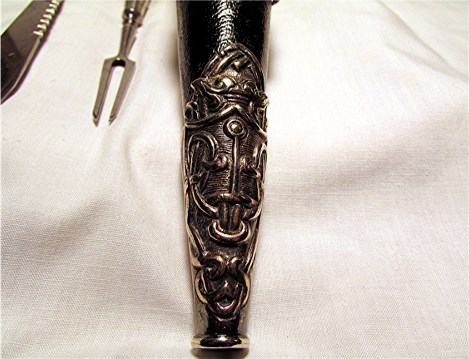
 Attachment: 54.34 KB Attachment: 54.34 KB
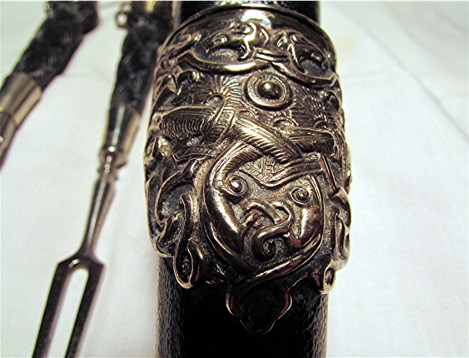
 Attachment: 29.17 KB Attachment: 29.17 KB
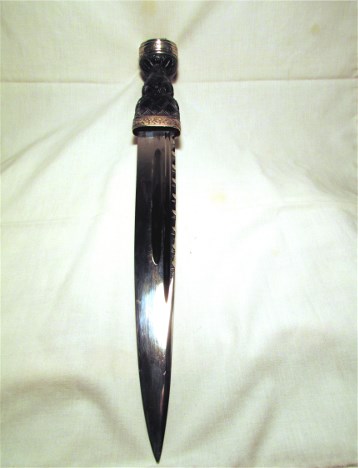
 Attachment: 49.41 KB Attachment: 49.41 KB

|
|
   |
 |
|
Lin Robinson
|
 Posted: Sat 21 Dec, 2013 6:21 am Post subject: Posted: Sat 21 Dec, 2013 6:21 am Post subject: |
 |
|
Scott...
Thanks for the additional photos.
The decoration does not appear to be military. My belief is that this is a civilian dirk made some time around 1900 although, because dirks in this style continued to be made for many years, it could be much later. Lawrie was founded in 1881 so it does not date any earlier, or at least much earlier, than that. Peter Henderson was partnered with Lawrie at one time as a pipe maker but around 1880 Lawrie went out on his own. There are Henderson marked dirks as well. At least one of them is marked "Peter Henderson - Maker." To me, at least, the number of dirks marked by pipe makers and other retailers is an indication that the markings simply indicate who is selling them, not necessarily making them. Also, the wide variety of styles and decorations on dirks with Lawrie and Henderson markings makes me feel that they were custom made by a blade smith then marked for the seller. A number of dirks were marked by English companies.
Your dirk appears from the photos to be in very good to excellent condition. Of course most dirks made in the late 19th c. and after were ornaments rather than weapons so they were handled very little. Proper storage has kept many of them in pristine condition.
Values for these things are all over the place. They go for as little as $700 on up in the thousands, especially those with a military connection, silver mounts, etc.
More photos when you have time would be interesting.
Lin Robinson
"The best thing in life is to crush your enemies, see them driven before you and hear the lamentation of their women." Conan the Barbarian, 1982
|
|
  |
 |
|
Scott Arnold
Location: Philadelphia, Pa. Joined: 16 Dec 2013
Posts: 10
|
 Posted: Sat 21 Dec, 2013 1:05 pm Post subject: Posted: Sat 21 Dec, 2013 1:05 pm Post subject: |
 |
|
| Lin Robinson wrote: | Scott...
Thanks for the additional photos.
The decoration does not appear to be military. My belief is that this is a civilian dirk made some time around 1900 although, because dirks in this style continued to be made for many years, it could be much later. Lawrie was founded in 1881 so it does not date any earlier, or at least much earlier, than that. Peter Henderson was partnered with Lawrie at one time as a pipe maker but around 1880 Lawrie went out on his own. There are Henderson marked dirks as well. At least one of them is marked "Peter Henderson - Maker." To me, at least, the number of dirks marked by pipe makers and other retailers is an indication that the markings simply indicate who is selling them, not necessarily making them. Also, the wide variety of styles and decorations on dirks with Lawrie and Henderson markings makes me feel that they were custom made by a blade smith then marked for the seller. A number of dirks were marked by English companies.
Your dirk appears from the photos to be in very good to excellent condition. Of course most dirks made in the late 19th c. and after were ornaments rather than weapons so they were handled very little. Proper storage has kept many of them in pristine condition.
Values for these things are all over the place. They go for as little as $700 on up in the thousands, especially those with a military connection, silver mounts, etc.
Again thank you for your input Mr. Robinson, During my search I have only found one other dirk like mine (Picture with red background) I sent the seller several emails trying to get their information on its manufacture and age however they have not given me any help, I can only wonder why. I canít help but feel the ornate design of the mounts should help to determine when it was made. I could very well be wrong and they may not mean anything. I have never seen a depiction like the lion on the pommel, why not a lion rampant or Crown some other well known symbol. The white metal mounts on the top are they serpents, dragons? Nothing? I donít see why someone would go through so much effort to put something meaningless on a meaningful item such as a highland Dirk. I have seen a picture of the Black watch in it only the pipe major wore a dirk like this, everyone else wore a very plain dirk without fork and small knife. That tends to support the idea it was not made for the military but rather a civilians or pipers dress Dirk.
More photos when you have time would be interesting. |
 Attachment: 54.84 KB Attachment: 54.84 KB
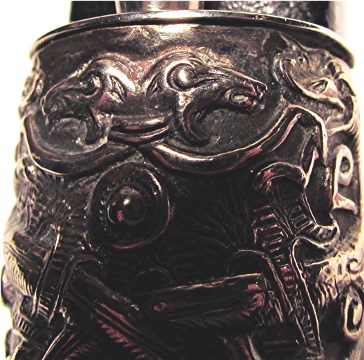
 Attachment: 21.84 KB Attachment: 21.84 KB

 Attachment: 10.56 KB Attachment: 10.56 KB
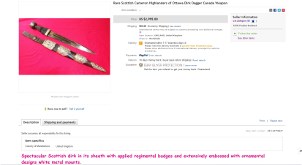
|
|
   |
 |
|
Lin Robinson
|
 Posted: Sat 21 Dec, 2013 3:27 pm Post subject: Posted: Sat 21 Dec, 2013 3:27 pm Post subject: |
 |
|
Scott...
Do you have the URL for the site selling the dirk in the screen shot? I would like to view it.
You have a tough row to hoe in determining the dates of manufacture on this dirk. There were thousands of dirks made in the 19th c. for the military as well as civilians. It is often hard, absent regimental markings or battle honors, to figure out which is which. Your dirk, with lions on the mounts along with some other mysterious decoration, doesn't reveal much about itself. As far as I know, there is no good reference on dirks, especially the later era dirks, in print. That is probably because the vast variety of decoration makes it hard to categorize and/or date them. I have an idea that it is late 19th c. from the Lawrie markings but as mentioned earlier it could be much later. Given that the company opened in 1881 and did business as R. G. Lawrie (only) until 1980 really exacerbates the problem.
The lion on the pommel got my interest and I looked through my references on military insignia of the British army and came up empty. I do not think it is a military dirk. The other symbols on the mounts are beyond my ken. Most military - and many civilian - dirks of the era were mounted with thistles which do not appear on your dirk.
At some point, if you really must know where this came from, you may have to take it to an expert for examination. I am out of ideas.
Lin Robinson
"The best thing in life is to crush your enemies, see them driven before you and hear the lamentation of their women." Conan the Barbarian, 1982
|
|
  |
 |
|
Scott Arnold
Location: Philadelphia, Pa. Joined: 16 Dec 2013
Posts: 10
|
 Posted: Sat 28 Dec, 2013 9:47 am Post subject: Posted: Sat 28 Dec, 2013 9:47 am Post subject: |
 |
|
| Lin Robinson wrote: | Scott...
Do you have the URL for the site selling the dirk in the screen shot? I would like to view it.
You have a tough row to hoe in determining the dates of manufacture on this dirk. There were thousands of dirks made in the 19th c. for the military as well as civilians. It is often hard, absent regimental markings or battle honors, to figure out which is which. Your dirk, with lions on the mounts along with some other mysterious decoration, doesn't reveal much about itself. As far as I know, there is no good reference on dirks, especially the later era dirks, in print. That is probably because the vast variety of decoration makes it hard to categorize and/or date them. I have an idea that it is late 19th c. from the Lawrie markings but as mentioned earlier it could be much later. Given that the company opened in 1881 and did business as R. G. Lawrie (only) until 1980 really exacerbates the problem.
The lion on the pommel got my interest and I looked through my references on military insignia of the British army and came up empty. I do not think it is a military dirk. The other symbols on the mounts are beyond my ken. Most military - and many civilian - dirks of the era were mounted with thistles which do not appear on your dirk.
At some point, if you really must know where this came from, you may have to take it to an expert for examination. I am out of ideas. |
Sorry Mr. Robinson a belated happy holiday, I originally found the listing on a Google search and selected imagines. It has since been listed on a site in the U.K. www.aasn.co.uk. When I first contacted them they sent me a form to fill out I did and returned it explaining I was just looking for information I received a reply saying because I was in the U.S. they were not interested?? I sent another message just asking for information and I have not heard from them again. Thank you so much for your help in this matter. May you have comfort and joy in the coming years. Scott W. Arnold
 Attachment: 12.06 KB Attachment: 12.06 KB
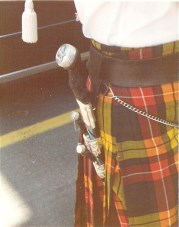
 Attachment: 13.41 KB Attachment: 13.41 KB
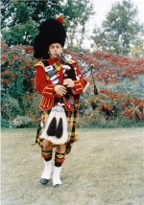
My Father from the 1960's
|
|
   |
 |
|
Ryan S.
|
 Posted: Sat 28 Dec, 2013 2:18 pm Post subject: Posted: Sat 28 Dec, 2013 2:18 pm Post subject: |
 |
|
|
The lion on the pommel is a crest, that is the top part of the coat of arms. It became very common just to put the crest on items such as silver or weapons. The lion is standing on a torse, which represents a way crests were attached to helmets. The lion is passant, which means it is standing on 3 legs. It is possible, that it represents the crest of owner. Although in Scotland, a single coat of arms belongs to an single individual, but family member often have similar, if not identical crests.
|
|
  |
 |
|
Lin Robinson
|
 Posted: Sat 28 Dec, 2013 4:01 pm Post subject: Posted: Sat 28 Dec, 2013 4:01 pm Post subject: |
 |
|
Thanks for providing the URL. They are pretty sure you will not be bidding on their antiques which is why they blew you off. Not a good business practice however because should I ever hit a good lottery number I am headed to Scotland to make some bids myself!
The dirk illustrated on the auction site has an apparent military connection with the Cameron Highlanders crest badges applied. However, I think that badges were not original to the dirk but were added later, which is what the auction company seems to think too. I believe it started as a civilian piece, was bought by someone with a regimental connection - or maybe not - who added the badge. I once bought a Fairbairn - Sykes commando knife with an SAS badge attached to the grip but the badge was definitely a later addition to the knife and made it very difficult to use. I feel pretty sure the knife was never owned by an SAS trooper.
The lion may be a crest, as Ryan says, but I am more inclined to think it is mere decoration. If the owner of this dirk was armigerous we probably would see more evidence of his arms on the dirk somewhere. Ryan's comments re: arms in Scotland are spot on, by the way.
Any way, you have an interesting and unusual dirk there, which has some value. I suggest you just keep your eyes open and some more information will eventually come along to help you in your quest.
Thank your for the good wishes and I extend my best wishes to you and your family for 2014 and beyond.
Lin Robinson
"The best thing in life is to crush your enemies, see them driven before you and hear the lamentation of their women." Conan the Barbarian, 1982
Last edited by Lin Robinson on Sat 28 Dec, 2013 4:07 pm; edited 2 times in total
|
|
  |
 |
|
Scott Arnold
Location: Philadelphia, Pa. Joined: 16 Dec 2013
Posts: 10
|
 Posted: Sat 28 Dec, 2013 4:01 pm Post subject: Posted: Sat 28 Dec, 2013 4:01 pm Post subject: |
 |
|
| Ryan S. wrote: | | The lion on the pommel is a crest, that is the top part of the coat of arms. It became very common just to put the crest on items such as silver or weapons. The lion is standing on a torse, which represents a way crests were attached to helmets. The lion is passant, which means it is standing on 3 legs. It is possible, that it represents the crest of owner. Although in Scotland, a single coat of arms belongs to an single individual, but family member often have similar, if not identical crests. |
Thank you Mr. Ryan S. Do I have this correctly labeled? What the lion is standing on is the Torse and because the Lion is facing and walking toward the viewer's left with one front leg raised makes it Passant. If the Lion is facing and walking toward the viewerís left with one back leg raised would make it Pissant?? (Sorry, sorry I could not help myself). If it were English in origin it would most likely point to an individual person but in Scotland it may be a symbol for a Clan?
 Attachment: 37.36 KB Attachment: 37.36 KB
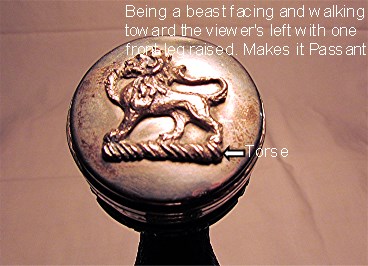
|
|
   |
 |
|
Scott Arnold
Location: Philadelphia, Pa. Joined: 16 Dec 2013
Posts: 10
|
 Posted: Sun 29 Dec, 2013 1:17 pm Post subject: Posted: Sun 29 Dec, 2013 1:17 pm Post subject: |
 |
|
| Scott Arnold wrote: | | Ryan S. wrote: | | The lion on the pommel is a crest, that is the top part of the coat of arms. It became very common just to put the crest on items such as silver or weapons. The lion is standing on a torse, which represents a way crests were attached to helmets. The lion is passant, which means it is standing on 3 legs. It is possible, that it represents the crest of owner. Although in Scotland, a single coat of arms belongs to an single individual, but family member often have similar, if not identical crests. |
Thank you Mr. Ryan S. Do I have this correctly labeled? What the lion is standing on is the Torse and because the Lion is facing and walking toward the viewer's left with one front leg raised makes it Passant. If the Lion is facing and walking toward the viewerís left with one back leg raised would make it Pissant?? (Sorry, sorry I could not help myself). If it were English in origin it would most likely point to an individual person but in Scotland it may be a symbol for a Clan? |
Again Thank you so much for your help Mr. Ryan S.,
I have spent quite a bit of time performing searches for "Scottish lion passant on Torse" Do you feel this is the correct way to approach this? Or is there another way I should be looking? Scott
|
|
   |
 |
|
Ryan S.
|
 Posted: Mon 30 Dec, 2013 7:05 am Post subject: Posted: Mon 30 Dec, 2013 7:05 am Post subject: |
 |
|
By default all heraldic animals face the views left. A crest like this alone is difficult to identify. Family members, in both Scotland and England are likely to have identical crests, in Scotland, clan members may have identical crests, but not always.
The main problem is that a lion passant is too common a crest, and you don't even know the colour of it. There are some books that attempt to list all the crests and mottos of every noble family in Britain. You can see in this copy of Fairbairn's https://archive.org/stream/fairbairnsbookof01fair/fairbairnsbookof01fair_djvu.txt Using your browser's search function you can see there are many persons to which this crest could belong. It is not a matter of looking for a needle in a haystack, it is looking for a specific needle in a stack of needles. If you had some other possible clues as to the owner, such as initials or a motto etc. Then you could narrow it down.
It is also possible, that the lion is mere generic decoration, however, that is more likely for things made today, than for in the 19th Century. I don't know much about piper's gear, but it seems that if the dirk belong to a piper, then that fact tells us more about the dirk, than the lion.
|
|
  |
 |
|
Scott Arnold
Location: Philadelphia, Pa. Joined: 16 Dec 2013
Posts: 10
|
 Posted: Mon 30 Dec, 2013 2:00 pm Post subject: Posted: Mon 30 Dec, 2013 2:00 pm Post subject: |
 |
|
| Ryan S. wrote: | By default all heraldic animals face the views left. A crest like this alone is difficult to identify. Family members, in both Scotland and England are likely to have identical crests, in Scotland, clan members may have identical crests, but not always.
The main problem is that a lion passant is too common a crest, and you don't even know the colour of it. There are some books that attempt to list all the crests and mottos of every noble family in Britain. You can see in this copy of Fairbairn's https://archive.org/stream/fairbairnsbookof01fair/fairbairnsbookof01fair_djvu.txt Using your browser's search function you can see there are many persons to which this crest could belong. It is not a matter of looking for a needle in a haystack, it is looking for a specific needle in a stack of needles. If you had some other possible clues as to the owner, such as initials or a motto etc. Then you could narrow it down.
It is also possible, that the lion is mere generic decoration, however, that is more likely for things made today, than for in the 19th Century. I don't know much about piper's gear, but it seems that if the dirk belong to a piper, then that fact tells us more about the dirk, than the lion. |
Again Thank you so much for your insights on the design of the Dirk. I was told by a collector of edged weapons that its often a long search to come to the facts of a blade and that is what he likes about collecting. For myself I have had the feeling I have been chasing ghosts and smoke. Thank you yet again Mr. Ryan S. The search go's on. Scott W. Arnold
|
|
   |
 |
|
Scott Arnold
Location: Philadelphia, Pa. Joined: 16 Dec 2013
Posts: 10
|
 Posted: Mon 06 Jan, 2014 10:31 am Post subject: My fathers Dirk Posted: Mon 06 Jan, 2014 10:31 am Post subject: My fathers Dirk |
 |
|
The one statement I have heard several times is I may need to consult an expert to get an appraisal for the Dirk. I donít mind spending a couple bucks to get the answers to the questions I have been asking. That being said, the next question I put the group. Who should I speak to?? As always thanks to all that have given guidance in this search. Scott
 Attachment: 34.61 KB Attachment: 34.61 KB
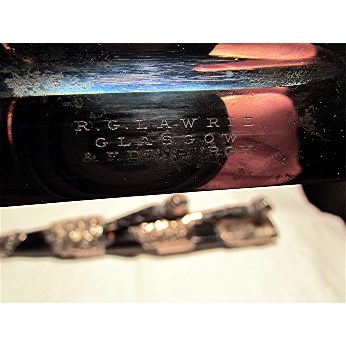
|
|
   |
 |
|
Lin Robinson
|
 Posted: Wed 08 Jan, 2014 4:42 am Post subject: Posted: Wed 08 Jan, 2014 4:42 am Post subject: |
 |
|
Scott...
Experts on this sort of thing are scarce in the US. One place where you might get some help is Scottish Sword and Shield. They have a web site but I do not know the URL off the top of my head. You can enter the name in your browser and probably come up with it. The company sells a lot of antique dirks, including some from the 19th and early 20th centuries, which would indicate some knowledge of their history and the history of their makers. If they cannot help they may have some resources they could recommend. Otherwise, you may have to talk to someone in the UK about your dirk, possibly someone involved with an auction house. However, I suspect there will be fees involved if you do.
Good luck and if you get any more information let us know.
Lin Robinson
"The best thing in life is to crush your enemies, see them driven before you and hear the lamentation of their women." Conan the Barbarian, 1982
|
|
  |
 |
Todd Salazar

|
 Posted: Thu 09 Jan, 2014 11:47 am Post subject: Posted: Thu 09 Jan, 2014 11:47 am Post subject: |
 |
|
I second Lin's recommendation of talking to Patrick Tougher of the Scottish Sword and Shield at http://scottishsword.com/. Patrick and his wife are located in Washington State. I would also recommend somebody at http://www.faganarms.com/. Faganarms, Inc is located in Michigan. Another, good website to look at is The House of Labhran at http://www.houseoflabhran.com/. The House of Labhran is located in Scotland and they sell some quality silver Victorian sgian dubhs and dirks on their website. They are quite knowledgeable about the dirk manufacturers of that reign. They actually have recently sold a dirk made by RG Lawrie at http://www.houseoflabhran.com/highland-wear-c...ling-.html and they may be willing to tell you what it sold for. Good luck with getting your valuation of your dirk! 
|
|
  |
 |
|
Scott Arnold
Location: Philadelphia, Pa. Joined: 16 Dec 2013
Posts: 10
|
 Posted: Thu 09 Jan, 2014 1:13 pm Post subject: Posted: Thu 09 Jan, 2014 1:13 pm Post subject: |
 |
|
| Todd Salazar wrote: | I second Lin's recommendation of talking to Patrick Tougher of the Scottish Sword and Shield at http://scottishsword.com/. Patrick and his wife are located in Washington State. I would also recommend somebody at http://www.faganarms.com/. Faganarms, Inc is located in Michigan. Another, good website to look at is The House of Labhran at http://www.houseoflabhran.com/. The House of Labhran is located in Scotland and they sell some quality silver Victorian sgian dubhs and dirks on their website. They are quite knowledgeable about the dirk manufacturers of that reign. They actually have recently sold a dirk made by RG Lawrie at http://www.houseoflabhran.com/highland-wear-c...ling-.html and they may be willing to tell you what it sold for. Good luck with getting your valuation of your dirk!  |
Thanks so much to you Mr. Robinson and to you as well Mr. Salazar for your help. I will continue my search and when (Keeping fingers crossed) I find the answers I will post my findings here. I know I don't have the only one in the world and I am sure everyone that has helped me would like to know as well. Scott
|
|
   |
 |
|
|
You cannot post new topics in this forum
You cannot reply to topics in this forum
You cannot edit your posts in this forum
You cannot delete your posts in this forum
You cannot vote in polls in this forum
You cannot attach files in this forum
You can download files in this forum
|
All contents © Copyright 2003-2025 myArmoury.com — All rights reserved
Discussion forums powered by phpBB © The phpBB Group
Switch to the Basic Low-bandwidth Version of the forum
|

